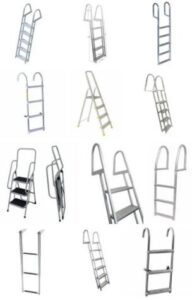Pontoon Ladder for Sale of this branded ladder is only 119,99 dollars. If you want to add more storage to your boat, Pontoon Boat Ladder Parts, you should consider purchasing.
These ladders have been designed for both recreational uses and commercial boat purposes. Many people who purchase them are not sure how to make the best selection. However, this is not difficult if you know what to look for in the item you plan to purchase.
Choosing the Perfect Pontoon Ladder for Your Watercraft
Choosing the perfect pontoon ladder for your watercraft is an important decision to ensure safety and convenience when getting in and out of the water.
There are several factors to consider when selecting a pontoon ladder, including materials, size, installation method, and additional features.
Here are some guidelines to help you make an informed choice:
- Materials: Look for a ladder made of durable and corrosion-resistant materials. Stainless steel is a popular choice as it withstands the harsh marine environment and offers excellent strength. Aluminum is also a good option as it is lightweight, easy to handle, and resistant to corrosion.
- Size and Length: Consider the height of your pontoon and the distance between the waterline and the deck. The ladder should be long enough to provide easy access without being too steep or requiring excessive effort to climb. Measure the distance accurately and choose a ladder with an appropriate length to match your needs.
- Folding or Fixed: Decide whether you prefer a folding or fixed ladder. Folding ladders can be folded up and stored when not in use, which saves space on the deck. Fixed ladders are permanently mounted and always ready for use. Choose the option that suits your preferences and available space.
- Step Design: Check the step design of the ladder. Look for wide, non-slip steps or rungs to provide stability and ensure a secure grip when climbing in and out of the water. Anti-slip materials, such as rubber or textured surfaces, enhance safety, especially when the ladder is wet.
- Weight Capacity: Consider the ladder’s weight capacity to ensure it can support the intended users. Pontoon ladders typically have weight ratings that specify the maximum load they can handle. Ensure the ladder is capable of accommodating the weight of individuals who will be using it.
- Installation: Review the installation requirements and method for the ladder. Some ladders may require professional installation, while others can be easily DIY-installed. Ensure the ladder comes with clear instructions and all necessary mounting hardware.
- Additional Features: Some pontoon ladders may have additional features, such as handrails, adjustable angles, or extra-wide steps. These features can provide added convenience and safety, especially for individuals with mobility limitations or children.
- Reviews and Recommendations: Before making a final decision, read customer reviews and seek recommendations from other pontoon boat owners. They can provide valuable insights into the quality, durability, and usability of different ladder options.
Remember, safety should be your top priority when selecting a pontoon ladder. Consider your specific needs and preferences, and choose a ladder that meets the necessary safety standards and offers convenience for you and your passengers.

Top Features to Consider in a Pontoon Ladder
When selecting a pontoon ladder, there are several important features to consider.
Here are some top features that can enhance the functionality, safety, and convenience of a pontoon ladder:
- Stability and Durability: Look for a ladder that is sturdy and stable, capable of supporting the weight of users without wobbling or flexing. The ladder should be made of high-quality materials, such as stainless steel or aluminum, that are resistant to corrosion and can withstand the marine environment.
- Step Design and Tread: The step design plays a crucial role in providing secure footing and preventing slips or accidents. Opt for a ladder with wide, non-slip steps or rungs that offer good grip even when wet. Textured or rubberized treads can further enhance safety.
- Folding or Fixed: Decide whether you prefer a folding or fixed ladder based on your space and storage requirements. Folding ladders can be folded up and stored when not in use, saving deck space. Fixed ladders are permanently mounted and always available for immediate use.
- Length and Reach: Consider the height of your pontoon and the distance between the waterline and the deck. Choose a ladder with an appropriate length to provide easy access without being too steep or requiring excessive effort to climb. Measure accurately to ensure a proper fit.
- Weight Capacity: Check the ladder’s weight capacity to ensure it can safely support the intended users. Pontoon ladders typically have weight ratings that specify the maximum load they can handle. Ensure the ladder can accommodate the weight of individuals using it.
- Installation Method: Review the installation requirements and method for the ladder. Some ladders may require professional installation, while others can be easily DIY-installed. Consider your capabilities and choose a ladder that suits your installation preferences.
- Compliance with Safety Standards: Ensure that the ladder meets or exceeds the necessary safety standards for marine equipment. Look for certifications or labels indicating compliance with relevant regulations, such as the American Boat and Yacht Council (ABYC) standards.
By considering these features, you can choose a pontoon ladder that provides a safe and convenient means of getting in and out of the water, enhancing your boating experience.
Step-by-Step Guide: Installing a Pontoon Ladder
Installing a pontoon ladder is a relatively straightforward process. Here is a step-by-step guide to help you through the installation:
Materials you’ll need:
- Pontoon ladder
- Mounting brackets (usually included with the ladder)
- Measuring tape
- Pencil or marker
- Drill
- Appropriate drill bits
- Screws or bolts (check the ladder instructions for the recommended size)
- Wrench or screwdriver
Step 1: Determine the ladder location
- Choose a suitable location on your pontoon boat to install the ladder. Consider factors such as accessibility, water depth, and interference with other boat components. It is usually best to install the ladder near the stern or at the rear entry point of the pontoon.
Step 2: Measure and mark the mounting points
- Hold the ladder up to the desired location and mark the positions for the mounting brackets on the pontoon’s exterior. Ensure that the ladder is level and properly aligned.
Step 3: Pre-drill the mounting holes
- Using an appropriate-sized drill bit, pre-drill holes at the marked positions on the pontoon’s exterior. Be cautious not to drill through the interior furniture or structural components.
Step 4: Attach the mounting brackets
- Line up the mounting brackets with the pre-drilled holes and secure them using screws or bolts provided with the ladder. Tighten them firmly but avoid over-tightening, which could damage the boat’s structure.
Step 5: Install the ladder
- Attach the ladder to the mounted brackets. Ensure that the ladder securely locks into the brackets and can support the weight without wobbling or coming loose. Follow the manufacturer’s instructions to correctly secure the ladder to the brackets.
Step 6: Test the ladder
- Before relying on the ladder for actual use, give it a firm shake to ensure it is securely installed. Put some weight on it, simulating the load it will bear when someone climbs it, and verify its stability.
Step 7: Make necessary adjustments
- If the ladder seems unstable or improperly aligned, make any necessary adjustments to the mounting brackets or ladder position. Ensure that the ladder is safe and level before using it.
Step 8: Regular maintenance and inspections
- To ensure the ladder remains in good working condition, regularly inspect the mounting brackets, ladder hinges, and any connecting points for signs of wear or damage. Lubricate moving parts if needed, and promptly address any issues that arise.
Note: This guide provides general instructions, but it’s crucial to consult the specific instructions provided by the manufacturer of your pontoon ladder for detailed installation steps and any specific requirements or recommendations they may have.
Comparing Different Types of Pontoon Ladders
When it comes to pontoon ladders, there are several different types available on the market. These ladders are designed to provide safe and convenient access to and from the water when you’re on a pontoon boat.
Let’s compare some of the common types of pontoon ladders:
- Folding Pontoon Ladders: Folding pontoon ladders are among the most popular options. They typically feature a hinged design that allows them to fold up when not in use, saving space on the boat. These ladders are usually made of aluminum or stainless steel and often come with non-slip steps for added safety.
- Slide-Out Pontoon Ladders: Slide-out pontoon ladders are integrated into the structure of the pontoon itself. They can be extended or retracted as needed, making them convenient to use. Slide-out ladders are usually made of durable materials like aluminum and provide a secure and stable platform for boarding and disembarking.
- Under-Deck Pontoon Ladders: Under-deck pontoon ladders are installed beneath the pontoon’s deck, typically on one of the side panels. These ladders are concealed when not in use, which helps maintain the aesthetics of the boat. When needed, they can be pulled out or deployed to provide access to the water. Under-deck ladders are often made of stainless steel or aluminum and can be sturdy and durable.
- Removable Pontoon Ladders: Removable pontoon ladders are designed to be easily attached or detached from the boat. They typically feature hooks or mounting brackets that allow for quick installation and removal. These ladders are portable and can be taken on and off the pontoon as needed. They are often made of lightweight materials such as aluminum and are suitable for occasional use.
- Boarding Ladders: Boarding ladders are another type of pontoon ladder that can be used for easy access to the boat. These ladders are typically mounted on the pontoon’s side rails and are designed to assist people in climbing onto the boat from the water. Boarding ladders often have handrails or grab handles for added stability.
When choosing a pontoon ladder, consider factors such as durability, ease of installation, storage requirements, weight capacity, and overall safety features.
Maintenance and Care Tips for Your Pontoon Ladder
Proper maintenance and care of your pontoon ladder are essential to ensure its longevity and safe use. Here are some tips to help you maintain and care for your pontoon ladder:
- Regular Cleaning: Rinse the ladder with fresh water after each use to remove salt, sand, or other debris. Use a mild soap solution and a soft brush to clean the ladder thoroughly. Avoid using abrasive cleaners or brushes that can damage the ladder’s surface.
- Inspect for Damage: Regularly inspect your pontoon ladder for any signs of damage or wear. Check for loose or missing hardware, cracked steps, bent rails, or any other structural issues. Address any problems promptly to prevent further damage or accidents.
- Lubrication: Apply a corrosion-resistant lubricant to moving parts such as hinges, bolts, and joints. This will help prevent rust and ensure smooth operation. Be sure to wipe off any excess lubricant to avoid slipping hazards.
- Storage: When not in use, store your pontoon ladder in a dry and secure location. Exposure to harsh weather conditions, excessive sunlight, or extreme temperatures can accelerate wear and deterioration. Consider using a ladder cover or storing it in a protective storage bag.
- Avoid Overloading: Be mindful of the weight capacity of your pontoon ladder and avoid exceeding it. Overloading the ladder can lead to structural damage or failure. If you have heavy items to transport, consider using a separate loading system or distributing the weight evenly across the ladder.
- Secure Attachment: Ensure that your pontoon ladder is securely attached to your pontoon boat. Use the appropriate mounting hardware provided by the manufacturer and follow the installation instructions carefully. Periodically check the ladder’s attachment points for tightness and make adjustments as needed.
- Safety Considerations: Always prioritize safety when using your pontoon ladder. Encourage users to face the ladder and hold onto the handrails while climbing up or down. Remind everyone to step carefully and avoid sudden movements. Additionally, consider installing nonslip treads on the ladder steps for added traction.
- Professional Inspections: It’s a good idea to have your pontoon ladder inspected by a professional periodically, especially if you frequently use your boat or notice any signs of damage. They can provide a thorough evaluation and recommend any necessary repairs or replacements.
Remember, following these maintenance and care tips will help extend the life of your pontoon ladder and ensure safe and enjoyable experiences for you and your passengers.
Why a Sturdy and Reliable Pontoon Ladder is Essential?
A sturdy and reliable pontoon ladder is essential for several reasons:
- Safety: A pontoon ladder provides a safe and convenient way to get in and out of the water when swimming, snorkeling, or engaging in other water activities. Without a ladder, climbing onto the pontoon can be challenging, especially for children, older adults, or individuals with limited mobility. A sturdy ladder ensures a secure grip and reduces the risk of slips and falls.
- Emergencies: In case of an emergency, such as someone falling overboard or needing to quickly exit the water, a reliable pontoon ladder becomes crucial. It allows for swift and efficient access to the pontoon, minimizing the time spent in potentially dangerous situations.
- Accessibility: A pontoon ladder makes it easier for people with disabilities or physical limitations to enjoy water activities. It promotes inclusivity by providing a means for individuals who may require assistance or support to enter and exit the water comfortably.
- Convenience: Having a ladder attached to your pontoon adds convenience to your boating experience. It eliminates the need to climb up and over the side of the pontoon, which can be awkward and tiresome. With a ladder, you can quickly and effortlessly get in and out of the water as desired.
-
Durability and reliability: A sturdy ladder is built to withstand the harsh marine environment, including exposure to water, sun, and corrosion. It should be constructed from high-quality materials such as stainless steel or aluminum to ensure its durability and longevity. A reliable ladder can handle regular use, resist damage, and provide years of safe and dependable service.
Overall, a sturdy and reliable pontoon ladder is essential for safety, emergency preparedness, accessibility, convenience, and durability.
It enhances the enjoyment of water activities and promotes a positive boating experience for everyone on board.
Pontoon Ladder Buying Guide: What You Need to Know
When it comes to buying a pontoon ladder, there are several factors to consider to ensure you make the right choice. A pontoon ladder is an essential accessory for your boat, providing easy access to the water for swimming, diving, or getting back on board after a swim.
Here’s a buying guide to help you understand what you need to know when purchasing a pontoon ladder:
-
Ladder Type: Pontoon ladders come in various types, including folding, telescoping, and removable ladders. Folding ladders are hinged and fold up against the pontoon when not in use. Telescoping ladders slide in and out, offering compact storage. Removable ladders are designed to be detached when not needed. Consider which type suits your needs and boat layout.
-
Material: Look for pontoon ladders made from durable and corrosion-resistant materials like stainless steel or aluminum. These materials are ideal for withstanding the harsh marine environment and ensure longevity.
-
Size and Length: Consider the ladder’s size and length to ensure it fits your pontoon boat properly. Measure the height from the waterline to the deck to determine the required ladder length. It’s important to choose a ladder with steps that comfortably reach the water to allow for easy boarding.
-
Weight Capacity: Check the ladder’s weight capacity to ensure it can support the intended users. Consider the weight of the heaviest person who will be using the ladder and choose a ladder with a higher weight capacity for safety.
-
Step Design: Look for pontoon ladders with wide and non-slip steps to provide stability and prevent slipping. Some ladders have angled steps or handrails for added convenience and safety.
-
Installation: Consider the installation process and whether it aligns with your preferences. Some ladders require permanent mounting, while others are designed to be portable and removable. Ensure that the ladder you choose is compatible with your pontoon boat’s configuration and mounting options.
-
Storage and Accessibility: If space is a concern, consider ladders that fold or retract for compact storage. Look for ladders that are easy to deploy and stow away, ensuring convenient accessibility without taking up too much space on your pontoon boat.
-
Quality and Durability: Opt for pontoon ladders from reputable manufacturers known for their quality and durability. Read reviews and check for any warranty offered to ensure you’re investing in a reliable and long-lasting product.
-
Safety Features: Look for additional safety features such as handrails, locking mechanisms, and non-slip surfaces on the ladder. These features can enhance user safety and provide peace of mind.
-
Budget: Determine your budget range before purchasing a pontoon ladder. Prices can vary based on the ladder type, material, and additional features. Consider the value, quality, and longevity of the ladder when comparing prices.
Remember to prioritize safety and usability when choosing a pontoon ladder. Taking the time to research and consider these factors will help you find a ladder that meets your needs and ensures a safe and enjoyable boating experience.


